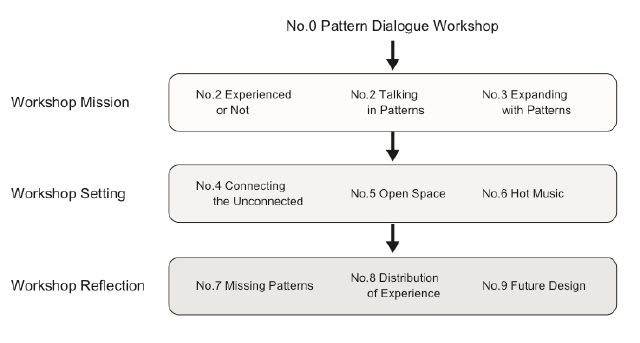
This page presents a pattern language for designing workshops where participants mine their own experience and talk about them with a pattern language. This language is composed of ten patterns describing the design knowledge for carrying out an effective workshop to use a pattern language: Pattern Dialogue Workshop, Experienced or Not, Talking in Patterns, Expanding with Patterns, Connecting the Unconnected, Open Space, Hot Music, Missing Patterns, Distribution of Experience, and Future Design. We anticipate that this language will help people introduce a pattern language into their community by carrying out the workshop.
When you want to introduce a pattern language to your community, active members will be willing to learn the pattern language, but others won't. People who do not feel the need are reluctant to learn the patterns, because it requires them to put effort into it. In result, the pattern language doesn't function as a common language in your community. Therefore, it is a good idea to hold a workshop for members to adapt to the pattern language with enjoyment. For example, you can hold a workshop where participants talk about their experiences with each other using the pattern language. The enjoyment in the workshop will help participants to think, learn, and talk about the patterns.
The Patten Language for Designing Workshop we present here is based on our experience of 25 workshops for various targets, in various domains, and in various places . In what follows, we will explain the types of workshops we held, and then present the patterns for designing such a workshop.
The workshops we held so far, which we call “Experience Mining and Dialogues Workshop,” consist of the following three phases: Experience Mining, Dialogues, and Reflection. In the first phase, Experience Mining, participants recall their experiences using the pattern language and make a list of patterns they have already experienced. In addition, they make a list of patterns they want to master in the near future. The second phase is Dialogues, the heart of this workshop. Each participant seeks others who experienced patterns he / she wants to master, and listens to their episodes. It is worthwhile to emphasize here that the pattern language functions to encourage participants to talk about their experiences, although people hardly talk about their experiences in their daily life. In the third phase, Reflection, participants talk about their discoveries from the workshop concerning their experiences and learn from the whole distribution of experiences of all participants.
As an example, we would like to introduce the case of the Learning Patterns, a pattern language for creative learning [1-4]. The Learning Patterns consists of 40 patterns describing practical knowledge for problem finding and problem solving in learning. We have held 19 workshops so far using the Learning Patterns. Holding a workshop using the Learning Patterns provides a good opportunity to encourage learners to talk about their ways of learning in their community. The workshop is designed so that the participants can talk about their experiences of learning in the light of the patterns [9,10] (Figure 1). First of all, a participant would make a list of patterns that he/she has already experienced, and chooses 5 patterns that he/she wants to gain in the near future. Then, he/she would look for a person who has experienced the learning pattern that he/she wants to gain, and listen to the experience of the learning. Through the workshop, participants acquire new vocabulary and a deeper understanding of the patterns. Furthermore, the workshop provides shared experience using the pattern language in their community, and thus the participants no longer have hesitation to talk about their experiences and knowledge in their community.
Whenever we hold these workshops, we are surprised at the excitement of participants. Based on our observations and surveys, the pattern language was used as a medium for reflecting their experience, and the workshops provide a good opportunity to understand the meaning of each pattern and to talk about how to learn with others.
Pattern-dialogue Workshop Patterns is composed of ten patterns describing the tips for carrying out an effective workshop to introduce a pattern language. Figure 2 shows the overview of the whole structure of this language.
The root pattern of this language is Pattern Dialogue Workshop (No.0). It describes when and why this pattern language for designing workshops is necessary. The first group of patterns is related to designing the mission of the workshop: Experienced or Not (No.1), Talking in Patterns (No.2), and Expanding with Patterns (No.3). Then, the second group is related to designing the workshop settings: Connecting the Unconnected (No.4), Open Space (No.5), and Hot Music (No.6). Then, the third group is related to designing the reflection session for the workshop: Missing Patterns (No.7), Distribution of Experience (No.8), and Future Design (No.9).
Each pattern is written in the same form: Pattern Name, Introductory Sentence, Picture, Context, Problem, and Solution. Pattern Name is the attractive and memorable words that could be used as a building block for the thinking process and a vocabulary for communication about the way of designing workshop to introduce a pattern language; Introductory Sentence and Picture are introductory parts of the pattern to show the pattern livelier; Context is the condition for applying this pattern; Problem describes a difficulty that often occurs in the context and is not easy to overcome; and Solution describes how to solve the problem. Note that Problem statement is written in bold-typed sentence just after the heading “In this context,” and Solution statement is shown as a bold-typed sentence just after the heading “Therefore.”

Make an opportunity for people to adapt to a pattern language with enjoyment.

You want to introduce a pattern language to your community.
In this context,
Although active members are willing to learn the
pattern language, others aren't. People who do not feel the need are reluctant
to learn the patterns, because it requires them to put effort into it. In
result, the pattern language doesn't function as a common language in your
community.
Therefore,
Hold a workshop for members to use the pattern
language with enjoyment. For example, you can hold a workshop “Experience
Mining and Dialogues Workshop,” where participants talk about their experiences
with each other using the pattern language. The enjoyment in the workshop will
help participants to think, learn, and talk about the patterns.
It is easy to answer whether one has experienced a pattern or not.
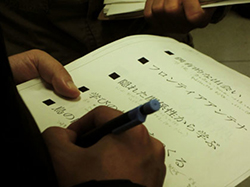
You've decided to offer a workshop to help participants adapt to a pattern language with enjoyment, and are designing the mission of the workshop. You are thinking of how the participants can learn and understand the patterns.
In this context,
The participants will become exhausted trying to
read through the catalog of patterns. Many of the patterns would require special
experience in order to understand them.
Therefore,
Make the participants pick up patterns they have
already experienced and make a list of them, as a preparation for the
workshop. This task is easily completed since they only need to focus on the
patterns they can understand. In other words, they don't have to distinguish
between the patterns they haven't experienced and the patterns they cannot
understand.
Practice makes perfect.

You've decided to offer a workshop where participants adapt to a pattern language with enjoyment, and are designing the mission of the workshop. You are thinking of how the participants can come to communicate with the pattern language.
In this context,
Participants will not use the patterns as
vocabulary in their daily life, even if they understand the patterns. It is
probably because they are novices in using pattern languages.
Therefore,
Design a mission where participants can practice
talking in the pattern language at the workshop. Through this experience,
the participants are expected be able to talk in the language without
hesitation.
Patterns can expand the experience in the near future.
You've decided to offer a workshop where participants adapt to a pattern language with enjoyment, and are designing the mission of the workshop. You are thinking how the participants come to use the pattern language as a guide for designing the target of the pattern language.
In this context,
Participants will not use the patterns as a guide
for designing in the target domain, even if they understand the patterns. It is
probably because they are novices in using pattern languages.
Therefore,
Make participants choose and create a list of
patterns they want to master in the near future. Making a list of patterns
they want to gain is the first step to designing their own way using a pattern
language.
Set game rules to encourage participants to perform out of the ordinary.

You've decided to offer a workshop where participants adapt to a pattern language with enjoyment, designed the mission, and are deciding the specific rules of the workshop.
In this context,
Some of participants are too shy to speak to
others in the workshop.
Therefore,
Forbid participants from talking to their friends or
acquaintances. This rule encourages participants to speak to other
participants that they do not know. Once they start to talk, the pattern
language and the workshop settings should make them confortable to keep
talking.
The environment changes the mood among the people.
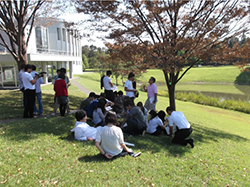
You've decided to offer a workshop where participants adapt to a pattern language with enjoyment, designed the mission, and are thinking about the place for the workshop.
In this context,
The participants will feel too formal to enjoy
talking if the workshop place is ordinary. It is because the nature of the space
affects the mind of participants.
Therefore,
Choose an open-air space or glass-sided room where
the participants can feel good and relax. Consequently, they will talk
easily and the workshop experience will be memorable.
No music, no workshop.

You've decided to offer a workshop where participants adapt to a pattern language with enjoyment, designed the mission, and are thinking about the environment for the workshop.
In this context,
The participants won't walk and talk actively,
especially at the beginning of the workshop.
Therefore,
Play groovy music that augments a scene where the
participants will talk and walk more actively. It is good to play the music
at a comparatively high volume at the beginning, because you can immediately
make the mood of the scene livelier. And, when closing the dialogue session, you
can emphasize the end of the workshop to the participants by stopping the
music.
Where are the missing patterns?
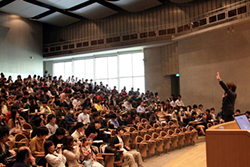
You've decided to offer a workshop where participants adapt to a pattern language with enjoyment, designed the mission and environmental settings, and are designing the reflection session.
In this context,
The participants often have patterns that they could not find anyone who had experienced the pattern within the given time. As a result, they feel uncomfortable and may think that those patterns are insignificant.
Therefore,
Ask for people with patterns that they could not find
anyone who with the experience, and match them up with those with experience of
the pattern. By finding and meeting people with experience with the pattern,
they will realize that the pattern is indeed important.
Understand yourself in respect to the whole distribution of experiences.
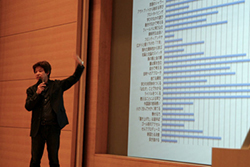
You've decided to offer a workshop where participants adapt to a pattern language with enjoyment, designed the mission and environmental settings, and are designing the reflection session.
In this context,
Participants have no chance to understand the
patterns that they did not choose.
Therefore,
Show graphs that summarize the distribution of the
experience of all participants for all patterns. If you use a program, you
can summarize the data on the spot, and show the graphs at the end of the
workshop.
Design a plan to achieve your goal using the pattern language.
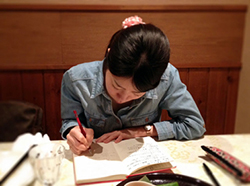
You've decided to offer a workshop where participants adapt to a pattern language with enjoyment, designed the mission and environmental settings, and are designing the reflection session.
In this context,
The participants will easily forget the episodes
they listened to in the workshop.
Therefore,
Encourage participants write their future vision
based on what they learned in the workshop with the pattern language. It can
be homework after the workshop.